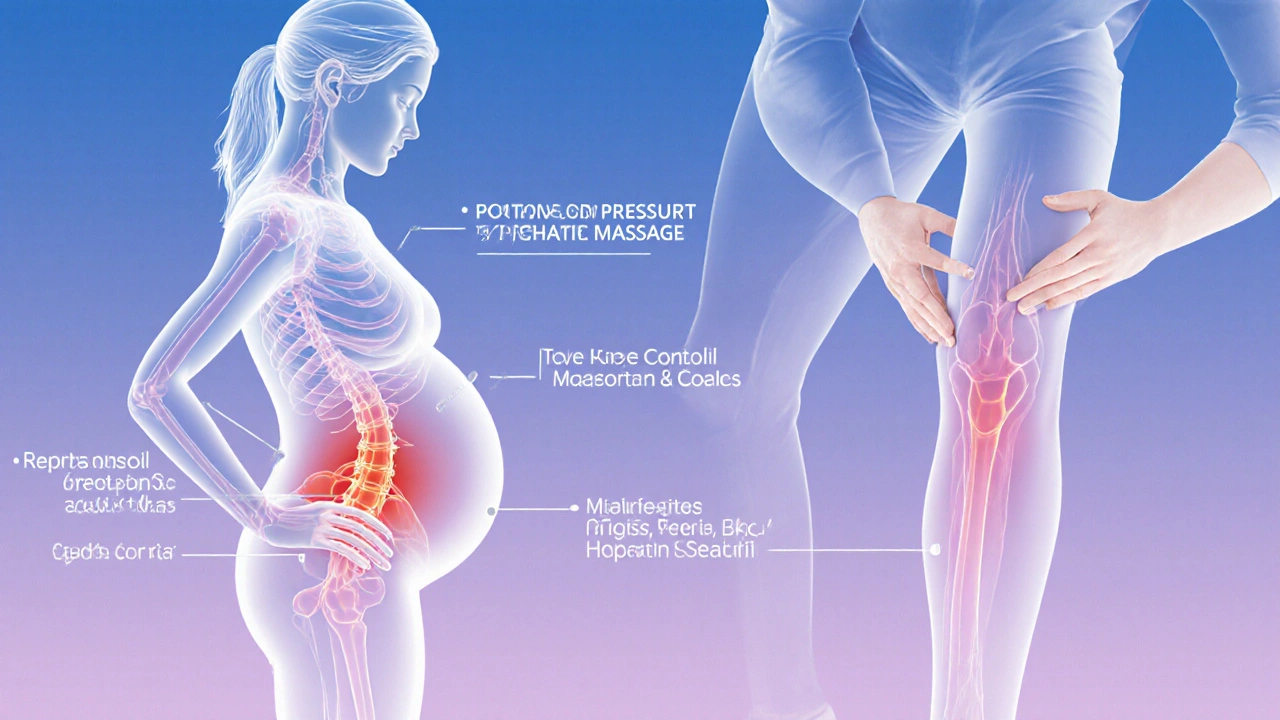Prenatal Massage: What It Really Does for Your Body During Pregnancy
 Nov, 15 2025
Nov, 15 2025
Prenatal Massage Safety Checker
Is Prenatal Massage Right for You?
This tool assesses whether prenatal massage is appropriate for you based on your pregnancy stage and health conditions. Always consult your healthcare provider before starting any new therapy.
When you’re pregnant, your body changes in ways no one ever fully prepares you for. Your center of gravity shifts, your joints loosen, your back aches, and sleep becomes a luxury. You might feel like you’re carrying a bowling ball in front of you while your hips scream for mercy. That’s where prenatal massage comes in-not as a luxury, but as a necessary tool for staying grounded, calm, and physically supported during one of the most demanding times in your life.
Why Prenatal Massage Isn’t Just a Treat
Prenatal massage isn’t about pampering. It’s about physiology. A trained therapist uses specific techniques to ease the physical stress of pregnancy. Studies from the Journal of Bodywork and Movement Therapies show that regular prenatal massage reduces cortisol levels by up to 30% and increases serotonin and dopamine-your body’s natural mood boosters. That’s not a side effect. That’s a direct result of targeted pressure on key muscle groups.Think about it: your pelvis is widening. Your lower back is curving more to balance your growing belly. Your diaphragm is pushed upward, making breathing feel harder. Your legs swell from fluid retention. These aren’t minor inconveniences. They’re structural changes that create real tension. A prenatal massage doesn’t just rub sore spots-it helps your body adapt.
What Happens During a Session?
You won’t lie face down. That’s not safe after the first trimester. Instead, you’ll be positioned on your side with supportive pillows, or in a semi-reclined chair designed for pregnant bodies. The therapist avoids deep pressure on the abdomen and inner thighs, and never targets certain acupressure points linked to labor induction unless you’re near term and it’s intentional.The session usually lasts 60 to 90 minutes. The therapist starts with your feet and calves-common trouble spots for swelling and cramps. Then they work up your legs, hips, and lower back using gentle, rhythmic strokes. They’ll use a blend of Swedish massage techniques: long gliding strokes, light kneading, and circular motions. No deep tissue. No aggressive adjustments. This isn’t a sports massage. It’s a slow, intentional release.
Many clinics use warm, unscented oils or lotions. Essential oils? Avoided unless you’ve cleared them with your OB-GYN. Lavender is common, but even that’s debated in early pregnancy. Simpler is safer.
Who Should Avoid It?
Most pregnant people can safely get a prenatal massage. But there are exceptions. If you have:- Uncontrolled high blood pressure
- Preeclampsia or severe gestational diabetes
- A history of preterm labor
- Placenta previa or other bleeding conditions
- Deep vein thrombosis (DVT)
you should skip it-or get written clearance from your doctor first. Even if you’re otherwise healthy, if you’ve had recent vaginal bleeding, dizziness, or severe headaches, wait until you’ve checked in with your care provider.
And yes, you can get one as early as week 12. Many therapists won’t take clients before then, not because it’s dangerous, but because morning sickness peaks around then. Wait until you’re past that phase. You’ll enjoy it more.
How Often Should You Get One?
There’s no hard rule. But most women benefit from monthly sessions until 28 weeks, then biweekly from 28 to 36 weeks, and weekly from 36 weeks until birth. That’s not because you need more massage later-it’s because your body is under more stress. The extra support helps you sleep better, move easier, and manage swelling.Some women start weekly at 32 weeks and swear by it. One client in Newcastle, who worked as a teacher and stood all day, said her leg cramps disappeared after two sessions. Another, who had chronic lower back pain since her first pregnancy, said this time, she didn’t need painkillers.

What’s the Difference Between Prenatal and Regular Massage?
A regular massage therapist might know how to relieve tension. But a prenatal specialist knows the risks. They know where not to press. They know how to position you so your uterus isn’t compressed. They know which muscles are tight because of hormonal changes, not just overuse.For example, the round ligament-stretching as your uterus grows-can cause sharp, stabbing pains on one side. A prenatal therapist uses gentle, targeted strokes along the ligament to ease the pull. A regular massage might miss it entirely or accidentally aggravate it.
Also, prenatal therapists are trained to recognize signs of complications. If your ankles are suddenly swollen on one side, or if you report sudden headaches, they’ll tell you to call your doctor. That’s part of their job.
Can You Do It at Home?
You can try self-massage, but it’s limited. You can’t reach your own back. You can’t properly support your hips. And you can’t easily relax while trying to massage yourself.That said, simple techniques help. Use a tennis ball against the wall to roll out your lower back. Sit on a cushion and gently press into your hips with your palms. Use a foam roller on your calves-never your lower back. A partner can help with shoulder and foot rubs. But none of this replaces a trained professional who understands the anatomy of pregnancy.
Real Benefits Beyond the Relaxation
Yes, you’ll feel calmer. But the real wins are physical:- Reduced sciatic nerve pain by up to 50% in regular users
- Improved circulation, which reduces leg swelling and varicose veins
- Lower risk of edema and carpal tunnel syndrome
- Shorter labor times in some studies-likely because stress hormones are lower
- Better sleep quality, especially in the third trimester
One 2023 study tracking 200 pregnant women found those who got weekly prenatal massages had 31% fewer instances of nighttime leg cramps and 27% fewer visits to their OB-GYN for musculoskeletal complaints.

Where to Find a Qualified Therapist
Look for someone certified in prenatal massage. In Australia, that means they’ve completed at least 135 hours of specialized training and are registered with a body like the Australian Association of Massage Therapy (AAMT) or the Australian Massage Therapy Association (AMTA). Don’t just go to the nearest spa. Ask if they’ve worked with pregnant clients before. Ask how they position women after 20 weeks.Some hospitals and midwifery clinics offer prenatal massage as part of their wellness programs. Check with your local maternity hospital. In Newcastle, several physiotherapy clinics include it as part of pregnancy care packages.
Cost and Insurance
A 60-minute session typically costs between $80 and $120 in Australia. Some private health funds with extras cover prenatal massage under ‘remedial massage’ benefits. Check your policy. You might get $50-$80 back per visit, up to a yearly cap. If you have a Medicare Chronic Disease Management plan, you might be eligible for rebates if referred by your GP.Don’t skip it because of cost. Think of it like a prenatal vitamin. It’s not optional if you want to stay comfortable and reduce long-term strain.
What to Expect After Your First Session
You might feel relaxed. You might feel a little sore. That’s normal. Your muscles have been holding tension for months. Release can feel tender. But you shouldn’t feel worse the next day. If you do, the pressure was too deep.Drink water. It helps flush out metabolic waste released during the massage. Avoid caffeine or alcohol afterward. You might feel sleepy. That’s okay. Let yourself rest.
Some women report emotional release too-tears, laughter, sudden calm. Pregnancy is a hormonal rollercoaster. Massage helps your nervous system reset. That’s not weakness. That’s your body healing.
Is It Worth It?
If you’ve ever stood in line at the grocery store and realized you can’t bend over to pick up your cart, or if you’ve woken up at 3 a.m. with your leg cramping so hard you couldn’t move-yes. It’s worth it.Prenatal massage isn’t about being indulgent. It’s about being smart. Your body is doing something extraordinary. You don’t have to suffer through it alone. This isn’t a luxury. It’s a tool. One that helps you stay strong, sleep better, and show up for your growing baby-not just as a mother, but as a person who deserves comfort too.
Is prenatal massage safe during the first trimester?
Yes, it’s generally safe after 12 weeks, but many therapists wait until then because morning sickness is often at its peak earlier. If you’re feeling well and have no complications, you can start earlier with your provider’s approval. Always avoid deep pressure on the abdomen and certain acupressure points, even in early pregnancy.
Can prenatal massage induce labor?
Not intentionally, and not in early or mid-pregnancy. Some pressure points-like SP6 (Sanyinjiao)-are linked to labor induction, but a certified prenatal therapist avoids them entirely unless you’re past 38 weeks and specifically requesting it to encourage labor. Even then, it’s done cautiously and only with medical approval. For most, the goal is relaxation, not stimulation.
Can I get a prenatal massage if I have gestational diabetes?
Yes, as long as your blood sugar is well-managed. Massage can improve circulation and reduce swelling, which helps with insulin sensitivity. But if you have neuropathy or poor circulation in your feet, your therapist will adjust techniques to avoid pressure on sensitive areas. Always inform them about your condition before the session.
Does prenatal massage help with postpartum recovery?
Absolutely. Many women continue massage after birth to ease muscle tension from carrying and feeding the baby, reduce swelling, and improve sleep. Some therapists offer postpartum-specific sessions that focus on the pelvis, shoulders, and lower back-areas most affected by newborn care. It’s not just for pregnancy-it’s for the whole journey.
What should I wear during a prenatal massage?
You can wear whatever makes you comfortable. Most people keep their underwear on and are covered with a sheet or towel. The therapist will only uncover the area being worked on. Some prefer to wear loose shorts and a tank top. The key is feeling safe and relaxed. Your comfort comes first.
Can my partner join me during the massage?
Some clinics allow partners to stay in the room for emotional support, especially if you’re feeling anxious. But the session is designed for you to relax without distractions. If your partner is there, they’ll usually sit quietly in a chair. Don’t feel pressured to include them-this is your time.
If you’re considering prenatal massage, start by asking your midwife or OB-GYN for a referral. Many clinics now include it as part of standard pregnancy care. Don’t wait until you’re in pain. Get ahead of it. Your body is working hard. Give it the support it deserves.
